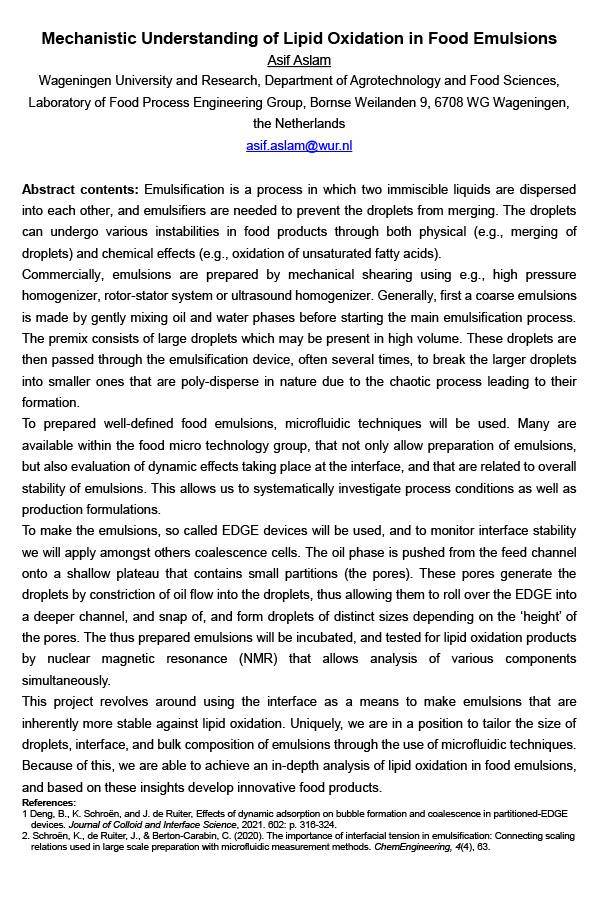Abstract contents: Emulsification is a process in which two immiscible liquids are dispersed into each other, and emulsifiers are needed to prevent the droplets from merging. The droplets can undergo various instabilities in food products through both physical (e.g., merging of droplets) and chemical effects (e.g., oxidation of unsaturated fatty acids). Commercially, emulsions are prepared by mechanical shearing using e.g., high pressure homogenizer, rotor-stator system or ultrasound homogenizer. Generally, first a coarse emulsions is made by gently mixing oil and water phases before starting the main emulsification process. The premix consists of large droplets which may be present in high volume. These droplets are then passed through the emulsification device, often several times, to break the larger droplets into smaller ones that are poly-disperse in nature due to the chaotic process leading to their formation. To prepared well-defined food emulsions, microfluidic techniques will be used. Many are available within the food micro technology group, that not only allow preparation of emulsions, but also evaluation of dynamic effects taking place at the interface, and that are related to overall stability of emulsions. This allows us to systematically investigate process conditions as well as production formulations. To make the emulsions, so called EDGE devices will be used, and to monitor interface stability we will apply amongst others coalescence cells. The oil phase is pushed from the feed channel onto a shallow plateau that contains small partitions (the pores). These pores generate the droplets by constriction of oil flow into the droplets, thus allowing them to roll over the EDGE into a deeper channel, and snap of, and form droplets of distinct sizes depending on the ‘height’ of the pores. The thus prepared emulsions will be incubated, and tested for lipid oxidation products by nuclear magnetic resonance (NMR) that allows analysis of various components simultaneously. This project revolves around using the interface as a means to make emulsions that are inherently more stable against lipid oxidation. Uniquely, we are in a position to tailor the size of droplets, interface, and bulk composition of emulsions through the use of microfluidic techniques. Because of this, we are able to achieve an in-depth analysis of lipid oxidation in food emulsions, and based on these insights develop innovative food products.
References: 1 Deng, B., K. Schroën, and J. de Ruiter, Effects of dynamic adsorption on bubble formation and coalescence in partitioned-EDGE devices. Journal of Colloid and Interface Science, 2021. 602: p. 316-324. 2. Schroën, K., de Ruiter, J., & Berton-Carabin, C. (2020). The importance of interfacial tension in emulsification: Connecting scaling relations used in large scale preparation with microfluidic measurement methods. ChemEngineering, 4(4), 63.
